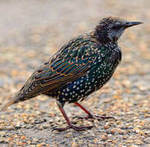The Government of La Rioja (Spain) acquires Bird Gard bioacustic repellers for bird control in experimental plantations.
In 2011, as part of the Actions Program in the La Rioja Biosphere Reserve, a project was initiated to plant various varieties of wild fruits in three experimental estates.
However, in recent years, the harvest of wild fruits has been reduced due to the presence of birds. These crop damages were particularly harmful in 2017. It was not an excessive increase in the bird population, which never reached the level of an infestation, but rather their presence was due to the scarcity of rainfall and the easy access to the estates from nearby mountains and forests. In this regard, the birds turned to the wild fruits in the estates due to the lack of natural food, causing significant damage to the crops.
In view of this situation and with the aim of improving the productivity of the estates, in 2018, the Directorate General of Environmental Quality and Water of the Ministry of Agriculture, Livestock, and Environment deemed it necessary to take preventive measures for bird control.
After analyzing various solutions available on the market, the decision was made to install Bird Gard bioacustic repellers.
2009: Collaboration Agreement Signing – Implementation of the Actions Program in the La Rioja Biosphere Reserve
The former Ministry of Tourism, Environment, and Territorial Policy, along with the Water and Waste Consortium and the Aguilar del Río Alhama City Council, signed a Collaboration Agreement with the Ministry of Environment and Rural and Marine Affairs in 2009 for the implementation of sustainable development actions outlined in the Actions Program in the La Rioja Biosphere Reserve (Official State Gazette No. 296, December 9, 2009).
Among the various actions to be carried out under this Agreement is a line of Research, Development, and Innovation (RDI) related to medicinal and aromatic plants, as well as wild fruits, as a sustainable activity within the territory of the La Rioja Biosphere Reserve. The objectives of this line of action are:
- Enhancing rural development by promoting population settlement and preventing depopulation.
- Providing various environmental benefits:
- Protection of natural environment and biodiversity.
- Defense against erosion.
- Utilization of marginal or barren lands.
- Potential for beekeeping development.
- Promotion of organic farming.
2011: Launch of the Experimental Plantation Project for Blueberries and Other Wild Fruits

In order to make the proper selection of wild fruits to cultivate in the experimental plots of the Reserve, research was conducted on their cultivation, yield, market, etc. Based on these analyses, blueberries were chosen as the main crop, supplemented with other wild fruits such as raspberries, currants, and blackberries.
During the months of March and October 2011, the project to plant experimental plots of various varieties of these species was initiated in three estates located in two municipalities of the Rioja Reserve: one estate in Cabezón de Cameros and two estates in Zarzosa.
2012 – 2017: Crop Reduction Due to Bird Presence

In the final years of the project’s development, the harvests were reduced due to the actions of groups of birds belonging to the genus Turdus (thrushes, starlings, blackbirds, etc.).
In order to improve the 2018 harvest, the General Directorate of Environmental Quality and Water of the Ministry of Agriculture, Livestock, and Environment of the Government of La Rioja deemed it necessary to take preventive measures for controlling birds harmful to these crops as they feed on their fruits.
2018: Acquisition of Bird Gard Bioacustic Repellers
Various solutions available in the market for bird pest control were considered: bird netting, sonic bird deterrents, etc.
- The option of placing bird nets over the crops was discarded due to the high economic cost, considering the size of the estates.
- As the most suitable solution, the installation of sonic bird deterrent systems was chosen, which emit specific sounds to repel this type of birds from the genus Turdus: thrushes, starlings, blackbirds.
After evaluating various market options in the field of sonic bird deterrents, the General Directorate of Environmental Quality and Water ultimately decided to acquire the Bird Gard Pro and Bird Gard Pro Plus bird deterrent systems with a specific microchip 61 for bird control of the Turdus species: thrushes, starlings, and blackbirds.
2018: Installation of Sonic Bird Deterrents in Three Experimental Estates of the Rioja Biosphere Reserve.
The BirdGard Pro #61 sonic bird deterrents were installed in the estate in Cabezón de Cameros and one of the two estates in Zarzosa.
The BirdGard Pro Plus #61 sonic bird deterrent was installed in the second estate in Zarzosa, which required a more powerful bird deterrent model due to its topographical characteristics.
The installation of the sonic bird deterrents took place in early June 2018, at the beginning of the berry fruit harvesting season. In total, the BirdGard sonic bird deterrents provide bird control for three estates with a combined total area of over 5,000 m2 and around 1,500 plants.
Thrush and Starling Deterrents – Other References
The following articles are references from other BirdGard Iberia customers who use Bird Gard bioacustic repellers to repel flocks of thrushes, starlings, and blackbirds:
- Dr. Martínez, Director of the Viticulture Group at CSIC (Spanish National Research Council), shares her experience with different methods to deter birds from vineyards.
- José Luis López Budia, a farmer in Cifuentes, explains how he has successfully protected his almond trees from woodpecker attacks and his cherry trees from thrush flocks.
- Bird Deterrents used to minimize micro power outages caused by starling flocks on power lines. Reference: Iberdrola
- Experience of one of BirdGard Iberia’s customers with the Bird Gard Pro bioacoustic bird deterrent, to get rid of starlings at their tourist complex in Mahón.
- Check other Customer References from BirdGard Iberia
If you have any doubts about the type of birds attacking your crops, we recommend the article: “Differences between Starlings, and Blackbirds”.


